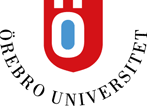Projects
The MR&O lab collaborates with numerous industrial partners and strives to integrate research work into industrial demonstrators. We are currently involved in the following key projects:
AIR
Action and Intention Recognition in Human Interaction with Autonomous Systems
Apr 1, 2015 – Mar 31, 2019
funded by KKS (SIDUS).
AIR investigates action and intention recognition in human interaction with autonomous systems (or AIR, for short). More specifically, the focus is on the interaction of humans and autonomous systems that move in shared physical spaces. The mutual recognition of actions and intentions between humans and the autonomous systems they interact with is absolutely crucial to ensure safety as well public acceptance of such technologies. Therefore, the research to be performed within the AIR distributed research environment will contribute to the success of future autonomous systems in society. Addressing the challenge of mutual action and intention recognition therefore requires a well-coordinated long-term interdisciplinary research effort that integrates expertise in cognitive science, experimental psychology, human factors, human-machine interaction, robotics, computer vision, and artificial intelligence – as constituted by the AIR consortium.
AMICI
Augmented Interaction for Human-Robot Collaborative Tasks in Industrial Environments
Jan 1, 2017 – Jan 1, 2020
funded by KKS (HÖG)
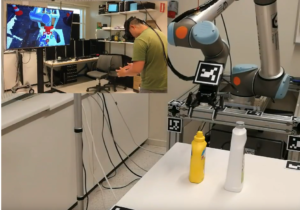
The goal of this project is to develop teleoperated robotic platform capable of doing variety of tasks in the additive manufacturing cell, while being supervised and teleoperated by a human operator. In this scenario, the operator is isolated from the hazardous environment, but the complex task can be performed using operator’s knowledge, skill, and intelligence.
FIREM-II
Jan 1 2019 – Dec 31 2021
funded by EIT Raw Materials (segment: up-scaling projects)
 Fires in mines put mining personnel at risk, can lead to production stops, cause large costs for standstill and represent great challenges for first responders. FIREM II aims to support the development of fully autonomous mines and contribute to safe and efficient fire and rescue operations. The goal is to further develop equipment, methods and certification for remote-controlled – not infrastructure-dependent – firefighting.
Fires in mines put mining personnel at risk, can lead to production stops, cause large costs for standstill and represent great challenges for first responders. FIREM II aims to support the development of fully autonomous mines and contribute to safe and efficient fire and rescue operations. The goal is to further develop equipment, methods and certification for remote-controlled – not infrastructure-dependent – firefighting.
This project is led by RI.SE and involves, in addition to the MRO lab at Örebro University, Boldiden Mineral AB, Dafo Brand AB, DMT GmbH, LTU Business AB, Luleå University of Technology, LKAB, Politechnika Slaska, Robotdalen, and Volvo Construction Equipment.
Örebro University is responsible for infrastructure-free positioning in smoke-filled environments, using novel radar sensor equipment and techniques for merging map information from heterogeneous sources in order to aid both autonomous and remote-controlled operation in low-visibility settings.
ILIAD
Intra-Logistics with Integrated Automatic Deployment: safe and scalable fleets in shared spaces
Jan 1, 2017 – Dec 31, 2019 funded by the European Comission (EU H2020 RIA).
 Today, intralogistic services have to respond quickly to changing market needs, unforeseeable trends and shorter product life cycles. These drivers pose new demands on intralogistic systems to be highly flexible, rock-solid reliable, self-optimising, quickly deployable and safe yet efficient in environments shared with humans. ILIAD project focuses on developing robotic solutions that can integrate with current warehouse facilities, extending state of the art to achieve self-deploying fleets of heterogeneous, human aware, safe robots in multiple-actor systems for extended periods of times.
Today, intralogistic services have to respond quickly to changing market needs, unforeseeable trends and shorter product life cycles. These drivers pose new demands on intralogistic systems to be highly flexible, rock-solid reliable, self-optimising, quickly deployable and safe yet efficient in environments shared with humans. ILIAD project focuses on developing robotic solutions that can integrate with current warehouse facilities, extending state of the art to achieve self-deploying fleets of heterogeneous, human aware, safe robots in multiple-actor systems for extended periods of times.
Scientifically, ILIAD pursues ambitious goals for complex cognitive systems in human environments beyond a specific use-case, primarily focusing on tasks related to safe human-robot interaction resulting in socially normative robot actions. Furthermore, the project will also address the problems related to integration of task allocation, coordination and motion planning for heterogeneous robot fleets.
SmokeBot
Mobile Robots with Novel Environmental Sensors for Inspection of Disaster Sites with Low Visibility
Jan 1, 2015 – Jun 30, 2018
funded by the European Comission (EU H2020 RIA).
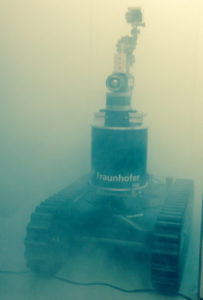 SmokeBot is driven by the application needs for robots that operate in domains with restricted visibility. The focus is on civil robots supporting fire brigades in search and rescue missions. Existing sensor technology and the related cognitive approaches cannot cope with such demanding conditions. SmokeBot addresses this shortcoming and can thus bring about a step change for robotics. It will deliver software and hardware components which facilitate robot systems to perform under harsh conditions of smoke, dust or fog. The ability to operate under low visibility conditions will be demonstrated through integration of the project results in an industrial prototype of a Low Visibility Explorer Robot for providing situational awareness based on a commercial platform from partner taurob. An even wider impact is expected through the development of a novel sensor unit and the corresponding cognitive approaches. Sensor technology from SmokeBot will result in new products to be brought to market after the project. Software developed will be made available as open source.
SmokeBot is driven by the application needs for robots that operate in domains with restricted visibility. The focus is on civil robots supporting fire brigades in search and rescue missions. Existing sensor technology and the related cognitive approaches cannot cope with such demanding conditions. SmokeBot addresses this shortcoming and can thus bring about a step change for robotics. It will deliver software and hardware components which facilitate robot systems to perform under harsh conditions of smoke, dust or fog. The ability to operate under low visibility conditions will be demonstrated through integration of the project results in an industrial prototype of a Low Visibility Explorer Robot for providing situational awareness based on a commercial platform from partner taurob. An even wider impact is expected through the development of a novel sensor unit and the corresponding cognitive approaches. Sensor technology from SmokeBot will result in new products to be brought to market after the project. Software developed will be made available as open source.
Semantic Robots
Oct 1, 2014 – Sep 30, 2020
funded by KKS (Profile)
There is a world-wide growing trend to introduce semantic information into robotic systems. This is evident in areas such as robot vision and mapping, human-robot interaction, and the use of ontologies for modelling of robot actions and perception. These efforts share many common research questions and issues, but work in each area is pursued in isolation and without being aware of the related achievements in the other areas. As a consequence, research and industrial applications on the intersection of robotics and semantic systems are in their embryonic stage worldwide and are underrepresented in Sweden.
Building upon our internationally recognized research in robot vision, rich 3D mapping, techniques for higher-level perception and task planning, we have initiated a research effort towards the unified development of Semantic Robots: such a robot uses a multi-semantic model of its environment that can be tailored to its action and perception capabilities in order to automatically derive and execute action plans that achieve given goals.
SURVEYOR
Surveying VEntilation sYstems in fOundries using Robots and stationary sensors
SURVEYOR is a pre-study (6-month) project aimed at improving the work space in foundries by using a better ventilation surveying approach. While indoor ventilation is critical due to the health and safety concerns associated with ambient air quality, current surveying techniques are overly simplistic and do not provide plant operators and occupational health specialists with accurate information regarding indoor airflow. Rather than relying on sporadic measurements and simplistic models, the proof-of-concept system in SURVEYOR addresses ventilation surveying using a mobile robot, static sensing nodes and advanced statistical modelling algorithms.
SURVEYOR will be developed in cooperation with Johnson Metall AB and Global Castings Guldsmedshyttan AB. SURVEYOR is funded by the strategic innovation programme STRIM (Strategic innovation programme for the Swedish mining and metal producing industry) which is part of a joint investment in strategic innovation areas (SIP) by Vinnova, Formas and the Swedish Energy Agency.
TracMac
Tracking and Control of Articulated Machines through Remote Sensing
August, 2017 – August, 2020
funded by SIP STRIM
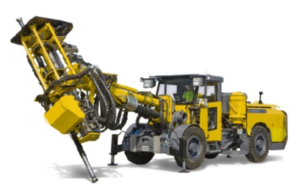 A key enabling technology for remote machine operation is the ability to estimate and control the full machine state. In the TracMac project we will devise and implement novel methods for estimating the state of articulated manipulators: using remote depth sensor measurements. We will verify the validity and utility of the state estimate by using it in a feedback controller. By removing all sensor hardware from the manipulator, we will greatly increase hardware robustness to damage and reduce repair and maintenance costs.
A key enabling technology for remote machine operation is the ability to estimate and control the full machine state. In the TracMac project we will devise and implement novel methods for estimating the state of articulated manipulators: using remote depth sensor measurements. We will verify the validity and utility of the state estimate by using it in a feedback controller. By removing all sensor hardware from the manipulator, we will greatly increase hardware robustness to damage and reduce repair and maintenance costs.
LOMAS++
Sweden’s First Autonomous Multi-functional Cultivation Test Bed becomes smarter.
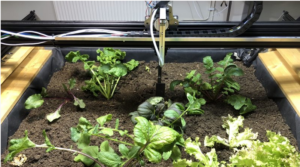 Preparing today for the global need of better tomorrow
Preparing today for the global need of better tomorrow
Sustainability sets the focus on the future. With this prototype, we aim to target for green sustainability bridging all the gaps, while focusing on maximizing food taste, and health. An, important key area of research highly associated with foods is the dimension of sensory perception. Humans sense the food perceived as an experience through their senses such as sight, smell, taste, touch and hearing. Now, when we talk about tasty and healthy food the sensory perception of a food always comes in the picture like juiciness, appearance, odor, flavor, taste and texture attributes etc. Conventionally, the evaluation of the food is done by experts in the related field. To increase the intake of tasty & healthier foods it is important to understand and focus on the sensory evaluation. Thus, sensory evaluation is a very important measurement for the delivery of high quality, and tasty foods.
Further, scaling the food production to meet the future human needs is challenging especially in comparison with the carbon footprints. Approximately, a quarter of worlds CO2 emission comes from food production, and the global climate impact of agriculture is increasing day-by-day. The irony is that agriculture itself is the main contributor to climate change, while in turn it is severely affected by it. So, this brings to the need for the food cultivation change. There is always a need for organized indoor cultivation for maximizing harvest on a smaller compatible surface with optimized usage of resources. We aim to focus on these individual aspects which makes – “LOMAS++” a perfect choice for indoor cultivation.
Past Research Projects
Find a complete list of past collaborative research projects here.
